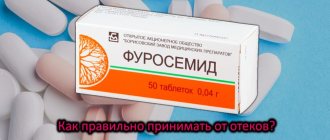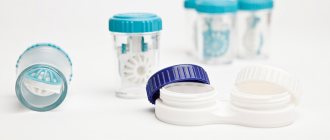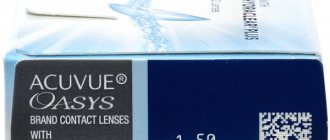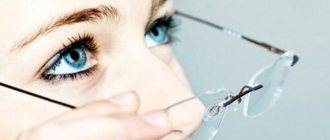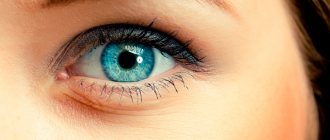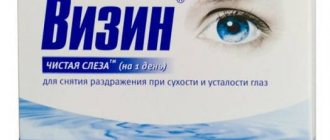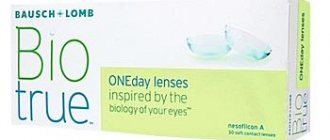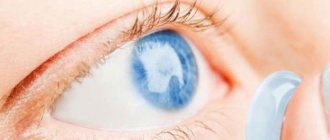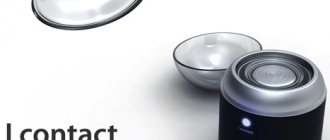Why do you need lens solution?
Contact optics care products are not needed if you wear daily ophthalmic products. Once removed, they are immediately thrown away. This is very convenient and hygienic, but such contact optics also have a drawback. It costs a little more than its other varieties. Therefore, many people prefer lenses designed for more than one use - biweekly, monthly, quarterly and traditional.
Why do you need contact lens solution when using menstrual and other routine replacement models? During the day, contaminants that enter from the external environment (particles of cosmetics, dust) and organic deposits contained in the tear fluid accumulate on their surface. They noticeably worsen the optical properties of contact optics. Over time, it becomes cloudy and can no longer provide high-quality vision correction.
There may be other consequences. Protein and lipid deposits can cause an allergic reaction. A person’s eyes turn red, irritation begins, itching and burning occur. It is impossible to wear lenses if these symptoms are present.
Moreover, deposits on lenses can become a source of bacteria. If lenses are not treated with solutions that provide disinfection, the risk of developing infectious eye diseases increases. The most common of them are acanthamoeba keratitis, conjunctivitis, blepharitis, etc. For these diseases, you will also have to abandon contact optics for the duration of treatment.
This is the main purpose of solutions for lenses - to clean them from deposits and disinfect them. Cleaning liquids also perform other functions. In them, ophthalmic products are stored after removal and until the next use. Lenses are at least ⅓ water. They should not lose moisture or dry out. It will then be unsafe to wear them. Some solutions have a moisturizing effect. They endow contact optics with hydrophilic properties, making wearing more comfortable.
The functionality of the solution depends on its composition. Some products are designed only for cleaning and storing lenses, while others perform almost all functions. With their help, you can carry out a full cycle of processing ophthalmic products - from cleansing to storage and rinsing. Which solution should I choose? This depends on several factors:
- type of contact optics;
- medical indications;
- financial capabilities;
- personal preferences.
Let's find out what solutions for contact lenses exist.
Types of lens solutions
There are 4 types of solutions in total:
- peroxide;
- enzymatic;
- universal;
- multifunctional.
Previously, water-salt solutions were used. They were only suitable for cleaning and storing contact optics. It was impossible to disinfect it with their help. Sometimes saline solution (sodium chloride) is used, but only in cases where a special product for caring for ophthalmic products is not available.
Universal solutions are suitable for processing all types of lenses - soft and hard, hydrogel and silicone hydrogel, transparent and colored. All universal care products are also multifunctional. We will describe the features of other types of cleaners and find out which one is better.
↑ Gas-tight and gas-permeable LCDs
Since these lenses are not germinated by microorganisms and fungi, caring for them is relatively simple. It is recommended to store liquid lens lenses in special containers, preferably in an aqueous environment, which, firstly, reduces the possibility of their deformation over time, and secondly, the use of disinfectant solutions makes it possible to disinfect the surface of the lens. Solutions containing alcohols (chlorobutanol, phenylethyl alcohol), ethers, acids (boric acid, ethylenediaminetetraacetate) are used as disinfectants.
When using these solutions
there are no problems associated with allergic and toxic reactions, since LCL, unlike SCL, do not adsorb disinfectants.
Caring for GP LCLs has its own characteristics compared to LCLs made from PMMA, since often the material from which gas-permeable lenses are made, and this is more often silicone lately, includes hydrophobic groups that reduce the wettability of the lenses. To increase wettability, the surface of the lenses is treated in a special way, but it can be eroded, which will lead to the appearance of hydrophobic areas on the surface of the lenses that attract proteins and partially lipids from the tear fluid. More lipids are deposited on fluoride lenses. This leads to the appearance of plaque on the surface of the lenses, which, unlike SCLs, does not penetrate deep into the material. Microorganisms multiply on these plaques and can infect the eye. Therefore, it is necessary to use special solutions containing cleaning, wetting, disinfecting and lubricating substances. These agents minimize plaque formation, reduce the possibility of microbial infection, and increase lens wettability.
Currently, combined solutions
containing disinfectants, cleansers and wetting agents. An example of such solutions is the Boston advance combination system, used for the care of fluoride-containing lenses and containing lipid-cleaning agents (tenide), wetting agents that provide comfort when wearing lenses, and disinfectants. The Boston Simplicity combination solution also contains agents that remove proteins and lipids (surfactants) from the GCL, wetting agents and disinfectants.
as disinfectants
more often mercury-free drugs, for example, benzalkonium chloride, chlorhexidine, polyaminopropyl biguanide.
It should be noted that when cleaning the GP LCD, you should not rub it too hard to prevent damage to the surface layer of the lenses. Thermal methods cannot be used to disinfect the lenses described, as this may lead to changes in lens parameters.
The best solutions based on hydrogen peroxide
Peroxide systems are based on hydrogen peroxide (H2O2), which is the best known antiseptic. The main task of such a solution is to disinfect contact optics. It is capable of destroying all types of pathogenic microorganisms. There are no preservatives in peroxide solutions, so they are suitable for allergy sufferers.
There are 2 types of such solutions - with a one-stage and two-stage cleaning system. Today the first type of purifiers are sold. They come complete with a container. It has a built-in catalytic platinum disc that neutralizes H2O2. This substance should not come into contact with the eyes as it may cause irritation.
The lenses are mounted in a special device, which is placed in a storage container and filled with solution. Within 4-6 hours, ophthalmic products are completely cleaned and disinfected. There is no need to rinse them after removing them from the container. For two-step cleaning, lenses should be rinsed in saline before wearing. But modern peroxide solutions eliminate this need, since they are produced together with a platinum disc.
This type of cleaning liquid is suitable for treating almost all types of lenses, except colored ones. Peroxide helps to destroy and wash out the coloring pigment. Because of this, the decorative properties of the lenses deteriorate. They will have to be thrown away. There are other disadvantages to peroxide solutions:
- can damage contact optics with a high level of moisture content when stored in solution for a long time;
- they are inconvenient to take with you on the road;
- cannot be used for rapid lens processing.
Peroxide systems are usually preferred by people who wear quarterly and traditional type contact lenses, that is, with a long service life. They are also suitable for tough ophthalmic products that require deeper cleaning.
Popular peroxide solutions:
- One Step (Sauflon);
- Aosept Plus (Alcon);
- Piiloset Soft A+B (Piiloset);
- Queen's Peroxide (Soleko);
- Ever Clean (Avizor).
↑ Soft contact lenses
Caring for SCLs is much more difficult, since these lenses, in addition to disinfection, require special methods of storage and cleaning from deposits.
For storing micro contact lenses,
outside the eye, special saline solutions are used whose characteristics resemble the composition of tears, i.e. with the appropriate osmotic pressure and pH, otherwise the water content and lens parameters may change, which will affect the fit of the lenses on the eye. Thus, storing SCLs in water leads to swelling of the lenses; excessive acidity or alkalinity of the solution can lead to the breaking of polymer bonds in the lens. Typically, lenses are stored in isotonic solutions, since hypertonic solutions promote dehydration of the lenses, which leads to their “shrinking,” and hypotonic solutions cause the lenses to swell.
To better preserve the properties of the solution, a buffer substance is added to it to maintain the pH within physiological limits (boric acid, sodium borate, citrates, phosphates, tromethamine, etc. are usually used), as well as a bacteriostatic preservative that inhibits the proliferation of microbes. Substances used to disinfect SCL are often used as preservatives, but in lower concentrations and do not have a toxic effect on eye tissue. The most commonly used:
• quaternary ammonium compounds (NH4+), for example, the polymer compound polyquarternium-1 (polyquad);
• biguanides, for example, polymer compounds such as polyhexamethylene (), polyaminopropyl (), etc.;
• oxidizing agents, for example, a weak solution of hydrogen peroxide, which is not toxic to eye tissue (Sauflon); • alcohols and weak acids, for example sorbic acid, which, however, can cause yellowing of the lenses;
• organic mercury compounds, for example, thimerosal, which in the concentrations used (0.001-0.004%) can cause dry eye syndrome and allergic reactions in some patients.
To enhance the effect of preservatives, so-called chelating agents can be used. The most widely used is ethylenediamine tetraacetic acid (EDTA), which forms a complex with calcium ions, which contributes to the destruction of the cell membrane of microbes.
Some first generation preservatives
- chlorhexidine, thimerosal - turned out to be quite toxic, causing eye irritation. In recent years, new types of preservatives have been developed - Dimed, Polyquad, which do not cause side effects.
In addition to storing lenses, saline solutions are used for thermal disinfection and for rinsing lenses after cleaning.
One of the most important factors
The defining feature of SCL care is the formation of deposits on lenses, which, having small molecular sizes, easily penetrate through the pores of the lens material. This leads to patient complaints of discomfort due to the mechanical effect of deposits on the eye; the appearance on the surface of the lenses of areas with poor wettability, which impairs the supply of oxygen to the cornea. Decreased lens transparency leads to decreased visual acuity.
Sediments can be divided into organic, inorganic and mixed.
Most of the deposits are proteinaceous, which are not always visible to the naked eye. The main protein that determines the contamination of SCL is lysozyme, which plays a bactericidal role in tears. The small size of the molecules of this protein makes it relatively easy to penetrate hydrophilic materials; its positive charge determines a strong ionic bond with the polymer. Protein deposits also contain albumin, globulin, etc. Protein is deposited most quickly on SCLs with a high water content, since the material of these lenses is more porous, which facilitates the penetration of protein into the matrix.
Protein deposits on SCL
They begin to form on the first day of wearing lenses. At first these deposits are visible as sparse translucent spots, then they merge to form a thin film. As the lens ages, surface proteins under the influence of high temperatures (during thermal disinfection) undergo denaturation (Fig. 58).
Deposits of denatured proteins, in addition to mechanically affecting the cornea and reducing vision in lenses, can cause an immune reaction in the eye. This reaction, according to some researchers, largely determines the appearance of such a complication as giant papillary conjunctivitis.
Lipid deposits get onto lenses from tears, glandular secretions (for example, from the meibomian glands), from cosmetics, lotions, from oily deposits on the hands, etc. These deposits usually form on the surface of the lenses, often on top of existing protein deposits and look like greasy stains. Lipid deposits are hydrophobic, which leads to drying of the lens surface and causes discomfort in patients. In addition, there may be mucin deposits on the lenses (Fig. 59), which often form where other deposits already exist and form complexes with them.
There are also deposits of inorganic substances (for example, calcium)
. These deposits are visible as whitish round spots. On the surface of the lenses you can observe rust-colored spots containing metal salts that fall onto the lens from dusty air; the growth zones of microbes and fungi are colored pinkish, orange, etc. It should be noted that pollution products often form complex complexes, including proteins, fats, and inorganic salts. These complexes usually cover the anterior surface of the SCL in the form of a film, but if such a lipoprotein film forms on the posterior surface of the SCL, the patient most often refuses to wear lenses. It should be noted that this film is a favorable environment for the proliferation of microorganisms.
Therefore, it is clear that special cleaning agents for MCL are needed. There are a number of special cleaning methods:
• desorption of organic deposits using surfactants;
• biochemical method of breaking down organic deposits using enzymes;
• chemical method of splitting using oxidizing agents.
Mechanism of action of surfactants (surfactants)
is that they reduce the surface tension of materials.
The macromolecule of these substances has two groups - hydrophilic (“head”) and hydrophobic (“tail”). The hydrophilic head of the molecule
is attracted by water and therefore, at the interface between two media (water-air), the surfactant molecules are oriented so that the “head” enters the aqueous environment, and the hydrophobic “tail” is attracted by anhydrous media, for example, fats, which leads to a decrease in the surface tension between particles. As a result, the polluting substance is crushed into small parts and is easily removed. Another possibility for the orientation of a surfactant molecule in an aqueous environment is micellization. It is based on the fact that the lipophilic (hydrophobic) part of the surfactant binds organic deposits, while the hydrophilic part is located outside in the aqueous layer.
Next, the surfactant molecules, together with organic deposits on the surface of the surfactant, form micelles, which contain lipophilic deposits inside. Micelles disintegrate in water and are easily removed. Thus, the surfactant makes organic deposits on the lenses “water soluble.”
For binding inorganic deposits (for example, calcium salts, iron salts, etc.)
, available in lenses, complexing agents are introduced into surfactant solutions. The fact is that calcium cations present in decomposition products on lenses can interact with anions of proteins, lipids and negatively charged groups that make up the polymer. These products interact with each other, preventing the removal of breakdown products. Therefore, so-called complexons that neutralize these substances (for example, EDTA) are often introduced into cleaning solutions.
Modern surfactants
are divided into ionic ones, which dissociate into ions (positively charged cations and negatively charged anions); and nonionic, whose molecules do not dissociate into charged particles. Non-ionic surfactants are less toxic compared to ionic ones. The most common nonionic surfactants (Tween, poloxamer, poloxamine, tyloxapol). Similar compounds are included in the Opti-Free solution. These surfactants are also included in the multifunctional solution ReNu MultiPlus, SOLO-care solution, and Complete solution. There are also amphoteric surfactants, the charge of which depends on pH (at high pH there are more anions in the solution, at low pH there are more cations). They are included in cleaning products for soft contact lenses produced, for example, by.
There are so-called strong surfactant cleaners, such as Opti-Clean; Miraflow, they contain abrasive particles that allow you to more effectively remove deposits on lenses.
Typical components of cleaning solutions containing surfactants are:
• substances that regulate the isotonicity of the solution (usually sodium chloride);
• a buffer system that maintains the pH state (usually boron and phosphorus compounds);
• complexons;
• disinfectant;
• material to increase the viscosity of the solution in order to lengthen the contact of the cleaner with the lens (cellulose derivatives).
There are complex cleaners with disinfectants, such as Hydrocare.
Another type of cleaner is enzymatic.
Enzymatic purification is based on the fact that an enzyme, a protein with active sites that enter into various chemical reactions, destroys the chemical parts inside protein deposits and, thereby, breaks them into small parts (peptides and amino acids), facilitating the removal of proteins. Most enzymatic cleaners are available in the form of tablets containing, in addition to the enzyme, substances that help dissolve the tablets (for example, tartaric acid, sodium bicarbonate) and a buffer system.
How to get rid of glasses, contacts and health problems forever. How to learn to see 100%? Michael Richardson will teach you this and much more with the “Seeing Without Glasses” program, which will teach you how to manage the Natural Health Functions of the Body and help you regain lost health and vision. Click here to get rid of diseases forever.
The enzymes used are: papain, found in cleaners such as Extenzym, subtilisin, found in, for example, Fizz Clean and Therma Clean cleaners; Ultrazym. These enzymes act mainly on protein deposits. The effect of subtilisin is enhanced at elevated temperatures, so this drug can also be used for thermal disinfection. Pancreatin contains a protease that acts on protein deposits, as well as lipase and amylase that remove lipid and mucin deposits. This enzyme is the basis of Opti-Free Enzymatic cleaner and Supra Clens. Please note that enzymes, like other proteins, can bind to the lens material and cause eye irritation. The safest, from this point of view, is subtilisin.
Oxygenators (sodium perborate, sodium percarbonate) and alcohols (hexylene glycol, propylene glycol) are also used as cleaners. However, a side effect of these drugs (change in lens shape) has been identified, so their use is currently limited.
Some cleaners for microlens lenses are recommended to be used daily (Opti-Free Daily Cleaner; Soft Lens Daily Cleaner; Supra Clens, etc.), others (Opti-Free Enzymatic Cleaner, etc.) weekly.
The usual bacterial flora of the eye, including pathogenic ones, is neutralized using the following mechanisms:
• blinking of the eyelids, in which foreign particles are mechanically pushed out of the eye;
• washing away bacteria that are not attached to the surface of the eye with tear fluid;
• precorneal tear film containing substances that destroy microbes (lysozyme, lactoferin, etc.);
• intact epithelium, which is a natural barrier to the penetration of infections into the cornea.
When wearing contact lenses, these systems may be disrupted (the epithelial barrier of the cornea is damaged, the metabolism and composition of tears changes).
As numerous studies have shown, the most common microbes identified in the conjunctival cavity of people using SCLs are: Pseudomonas aeruginosa, Staphylococcus, hemolytic and non-hemolytic streptococcus, Escherichia coli. These microorganisms most often cause conjunctivitis and keratitis, which can lead to ulceration of the cornea. Much less common are fungal eye diseases - mycoses, noted in less than 1% of eye infections associated with wearing lenses.
For disinfecting lenses
Three main types of antimicrobial effects are used: sterilization (temperature exposure up to 125°C), which allows the destruction of almost all types of microorganisms, including spores, or chemical exposure; disinfection (temperature exposure at 70°C) or chemical exposure that kills most microorganisms, i.e. bactericidal effect; preservation (inhibition of the growth of microorganisms), i.e. bacteriostatic effect. The type of antimicrobial effect when using chemicals depends on the concentration and duration of action of these agents. To disinfect contact lenses, patients mainly use disinfection.
As indicated, there are two main systems for disinfecting SCLs:
• thermal
- is based on the denaturation of cell components and the destruction of microorganism membranes at high temperatures (95-100°C). Typically, thermal disinfection is carried out in a container in a water bath for 20 minutes. It is recommended to perform this procedure 1-2 times a week.
However, it should be noted that thermal disinfection has a number of negative aspects: repeated heating of lenses leads to aging of the polymer and changes in the physicochemical properties and geometric parameters of the SCL, denaturation of protein deposits on the surface of the SCL. Therefore, thermal disinfection is recommended for lenses with low hydrophilicity, in patients with allergic reactions to disinfectant solutions. For heat treatment, special heat-heating devices are used, into which a container with SCLs filled with a solution for storing lenses is placed.
• chemical
Disinfection involves chemical damage to microorganisms. Antimicrobial substances can be classified into nonspecific and specific, which selectively act on proteins or the membrane of a microorganism.
Nonspecific disinfection agents, along with their antimicrobial effect, can be toxic to eye tissue. Therefore, specific disinfectants are more often used, for example, benzalkonium chloride, chlorhexidine, Dimed, polyquad, which selectively act on the membrane of microorganisms.
In disinfectant solutions for SCL
usually includes a disinfectant, a buffer system, and a system that maintains the osmoticity of solutions. Benzalkonium chloride, alkyltritanolammonium, biguanides (for example, chlorhexidine) and other substances containing mercury (for example, thimerosal) are used as disinfecting agents.
Tablets containing substances that release chlorine are used. Thus, she proposed Softab tablets containing sodium dichloroisocyanurate; — Aerotab tablets containing Galazon. The advantage of these tablets is that they do not contain preservatives that irritate the eyes.
For disinfection of SCL
in our country, a 3% solution of hydrogen peroxide is often used, into which SCLs are placed for 10-20 minutes, then to neutralize hydrogen peroxide, the lenses are treated with a 2.5% solution of sodium thiosulfate for 15 minutes and placed in a container with fresh saline solution for 5- 6 hours.
A one-stage method of disinfection using hydrogen peroxide has been proposed, the so-called AOSept system, when a platinum disk is lowered into the container where the lens is located, and a two-stage Oxysept system, when a tablet with catalase is placed in the container with the lens to neutralize the effect of hydrogen peroxide. These disinfectants clean the lens for up to 6 hours.
The main disadvantage
chemical disinfection is that the disinfectant penetrates into the lens material and, when putting on the lens, gradually comes out of it and can have an irritating effect on the eye. According to a number of researchers, solutions containing thimerosal are especially dangerous in this regard.
Domestic disinfectants for contact lenses are also produced, for example, taraclon containing the disinfecting agent catamine AB (an analogue of benzalkonium chloride), katacel (a combination of catamine AB with a sodium carboxymethylcellulose polymer that reduces the toxic effect of the disinfectant), kacel, miramistin (an antiseptic from the surfactant class ).
Currently, there is a trend towards creating universal multifunctional solutions for cleaning and disinfecting SCL. Thus, she created a multi-purpose solution ReNu MultiPlus, containing a surfactant (poloxamine, which removes lipids and loosely bound proteins), EDTA (which removes calcium, microbial deposits), antimicrobial agents with low toxicity to eye tissue (Dimed), boric acid, a buffer system for regulating the pH of the solution . This solution has cleansing and disinfecting properties, is easy to use, and practically non-toxic.
A complex solution has been proposed, Opti-Free, containing sodium citrate (this drug has a strong negative charge that attracts positively charged proteins); polyquad, which disinfects lenses; EDTA.
Currently, other multifunctional solutions are used in our country - SOLO-care soft; All in One; Complete Comfort Plus. All of these products, in addition to disinfecting and cleaning SCLs, can be used for storing lenses, and some can also be used as lubricants.
However, the need to use disinfectant and cleaning solutions complicates the care of SCL. Therefore, in 1988, SCLs were first proposed in the USA, which the patient himself changes as needed (for example, when deposits appear on the lens). These lenses are given to patients in sets of several pieces in sterile packaging. Currently, these SCLs are produced by many leading companies in almost the entire range of parameters, including spherical, toric, multifocal.
Modern SCLs, which are changed by the patient himself, are divided into three groups:
• planned replacement regiment - lenses that are replaced at intervals of 1 to 6 months and require disinfection and cleaning;
• disposable regiment lenses - lenses that are replaced at least once a month and require periodic disinfection and cleaning;
• one day disposable lenses – lenses that are replaced daily and do not require cleaning.
The shortened period of use of the second and third types of lenses does not allow deposits to accumulate on them, which reduces the likelihood of complications and significantly simplifies the care of SCLs. On long trips, patients may not need to take numerous care products with them. Relatively low prices make it cost-effective to use scheduled replacement lenses and replaceable SCLs. Currently, among the 26.2 million SCL users in the United States, about 10 million wear routine replacement lenses, 5.5 million wear replacement lenses, and about 10.2 million wear traditional SCLs (White R., Watanabe R., 1998). When issuing planned replacement SCLs to patients, it is imperative to emphasize the fact that these lenses do not require careful care, but if patients for some reason use them repeatedly, then in order to avoid complications, cleaning and disinfection of the lenses is necessary.
Enzymatic lens cleaners
Enzyme tablets and solutions are used for deep cleaning of protein deposits. These products do not replace peroxide and multifunctional cleaners, but are used in conjunction with them. Treatment with enzyme preparations is carried out every 7-10 days. This means that you only need to purchase them if you wear monthly, quarterly or traditional lenses. Two-week-old models do not need to be cleaned with enzyme agents.
Previously, such cleaners were produced only in tablets. The most famous of them is Enzyme from the Spanish company Avizor. The tablet is dissolved in a regular daily solution, after which the ophthalmic product is lowered into the liquid. After about 10-15 minutes, it should be removed from the container and washed in a fresh multi-purpose solution.
Today, enzyme cleaners are produced in liquid form: Boston Advance Cleaner from Bausch + Lomb, Delta from Sauflon, etc. It is recommended to use them together with multifunctional solutions from the same manufacturers.
Enzyme products are suitable for cleaning soft and hard lenses, but they are not used for cleaning colored models, nor are peroxide systems.
Multifunctional lens solutions
Today, multi-purpose products are more popular. They perform all the necessary functions:
- cleansing;
- disinfection;
- storage;
- rinsing;
- hydration;
- lubrication.
Many modern multifunctional lens solutions allow for rapid treatment without mechanical cleaning. In addition, they increase the comfort of wearing contact optics by moistening and lubricating them.
Such solutions are chosen by most buyers, as they are suitable for almost everyone, including people with sensitive eyes. Multifunctional products do not cause side effects. There are no contraindications to them. They are used for processing all types of contact optics. When purchasing such a cleaner, you only need to clarify which ophthalmic products it is intended for, soft or hard.
Solutions of this type are available on the market in large quantities. Which one should the buyer choose? How do products from different manufacturers differ? The doctor who selected contact optics for you can recommend a specific cleaner. Let us present for your information the best solutions for lenses, according to our customers.
Which lens solution is best to buy?
After reading the TOP of the best solutions for lenses, you can make the right choice without throwing money away. When going to the store, remember a few important tips from professional ophthalmologists:
- We advise those with sensitive eyes to opt for the Renu Bausch & Lomb MPS solution.
- Those looking for a good product at a low cost should buy Likosol-2000.
- Those who need an optimal solution for night lenses should purchase Medstar Lycotin-Neo-Multi.
- If you want to purchase a basic, multifunctional solution that does not cause an allergic reaction, take a look at Opti-Free Alcon Express.
- Those who value the opinion of professional ophthalmologists and their trust in the drug should, without hesitation, take Biotrue Bausch & Lomb universal.
- If cleaning your lenses is a priority for you, invest in CooperVision One Step's powerful cleaning solution.
- Fans of modern drugs who are willing to pay a little more should undoubtedly buy Solo Care Aqua.
Be careful when choosing and purchasing lens solution. Not only the degree of wear of the optics, but also the health of your eyes will depend on its quality. In our rating, we have collected the best products according to experts and ordinary buyers who unbiasedly evaluated each product on the market.
The best multifunctional solutions
The following multifunctional care products are popular:
- "Opti-Free Express" from Alcon. It contains polyquad, which protects against bacteria, aldox, a substance that destroys all types of mycoses, citrate, which removes protein deposits, and TETRONIK 1304, which eliminates lipids.
- Maxima from the manufacturer of the same name. The solution contains the Remopro component. It provides the deepest possible cleaning of soft ophthalmic products, eliminating the need for enzymatic treatment.
- "Licontin Universal" from the Russian. This solution is not only multifunctional, but also universal. It is suitable for the care of all types of lenses. This product is one of the best domestically produced.
We will separately list solutions for lenses for sensitive eyes.

